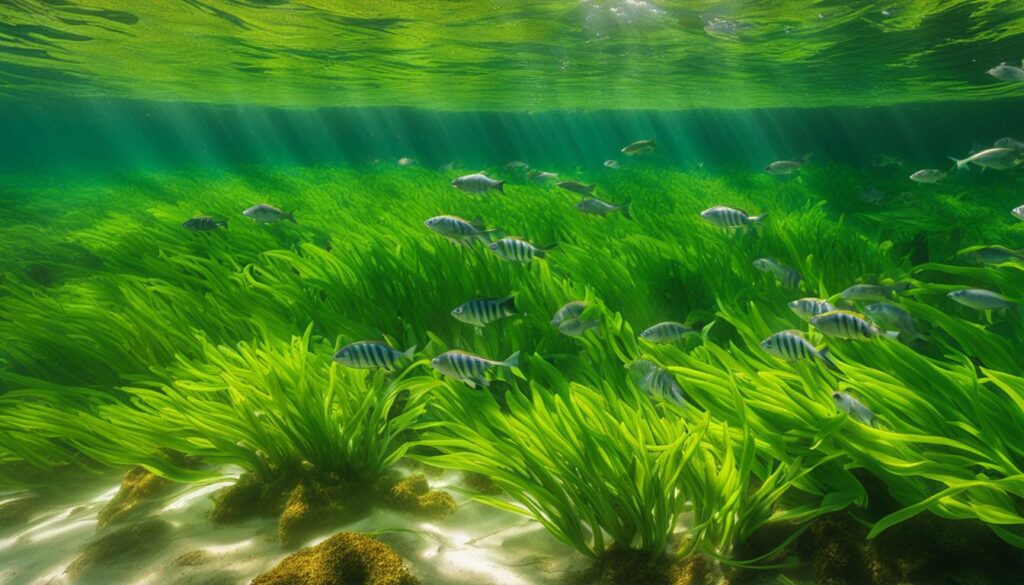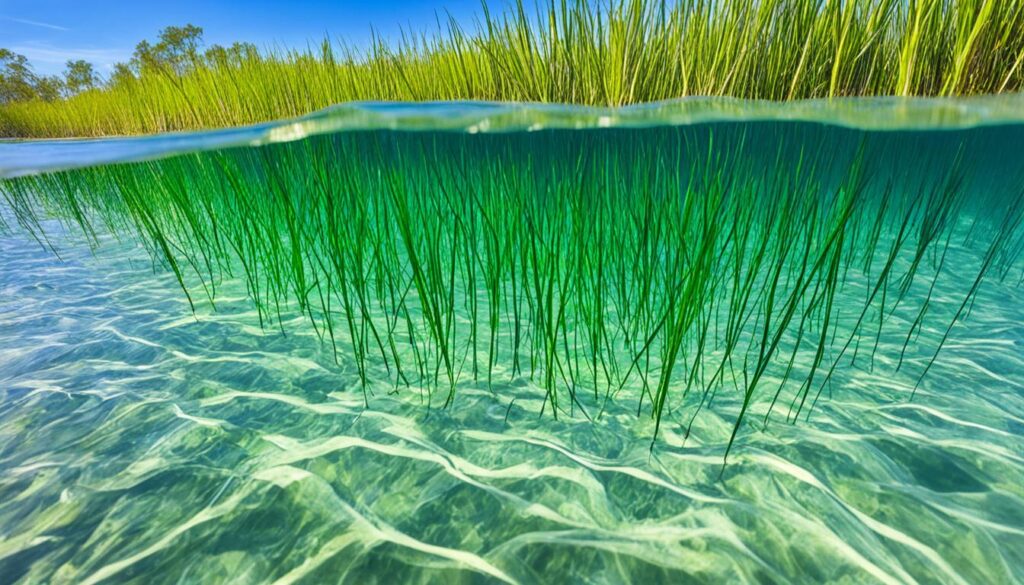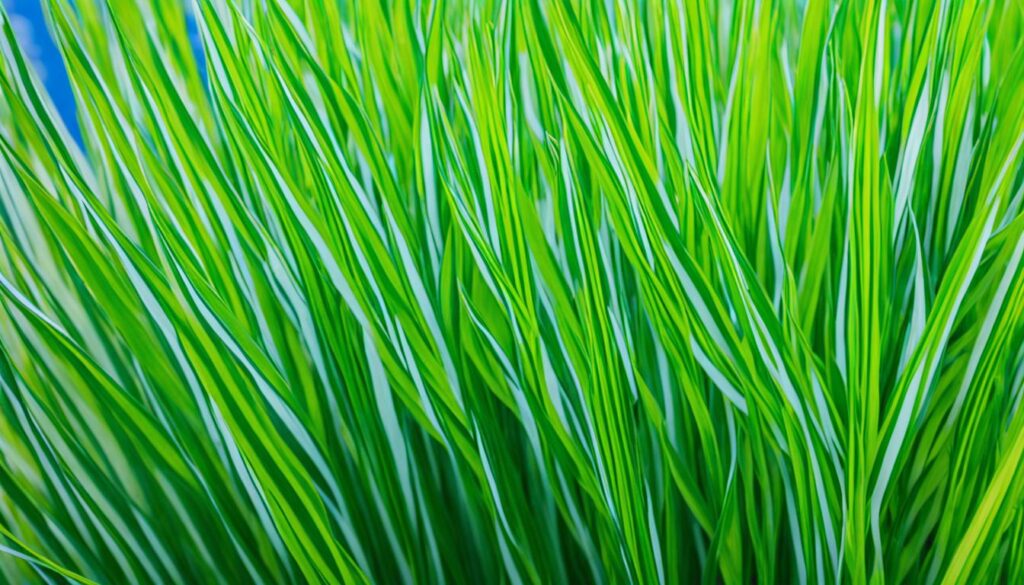Greetings! In this article, I will introduce you to the fascinating world of Tape Grass, a prominent aquatic plant found in the beautiful ecosystem of Florida. As we delve into the characteristics, habitat, and ecological importance of this aquatic gem, you’ll gain a deeper understanding of its significance in sustaining Florida’s rich biodiversity.
Key Takeaways:
- Tape Grass is a vital component of Florida’s aquatic ecosystems.
- It provides essential habitats for various aquatic organisms.
- Tape Grass plays a crucial role in maintaining water quality.
- Conservation efforts are underway to protect this valuable aquatic plant.
- Understanding the benefits and uses of Tape Grass can contribute to the sustainable development of Florida’s aquatic resources.
Understanding Tape Grass: Characteristics and Habitat
Welcome to the second section of our guide to the Tape Grass Florida Aquatic Plant. In this section, we will explore the characteristics and habitat of this fascinating aquatic plant, which plays a crucial role in Florida’s aquatic ecosystems.
Tape Grass, also known as Seagrass, is a submerged aquatic plant that thrives in the freshwater bodies of Florida, including rivers, lakes, and springs. Its long, ribbon-like leaves give it a distinct appearance, making it easily recognizable in its natural habitat.
One of the key characteristics of Tape Grass is its ability to create dense underwater meadows that provide essential habitats for various marine species. These meadows offer shelter, food, and breeding grounds for fish, crustaceans, and other aquatic organisms, contributing to the overall biodiversity of Florida’s aquatic ecosystems.
It’s important to note that Tape Grass is not a seaweed or algae, but rather a flowering plant with a complex root system. This root system anchors the plant firmly in the substrate, preventing it from being easily uprooted even in strong currents.
The long leaves of Tape Grass are an adaptation that allows it to efficiently capture sunlight for photosynthesis underwater. This process is essential for the plant’s survival as it converts sunlight into energy to fuel its growth and development.
Furthermore, the dense mats created by Tape Grass also play a vital role in maintaining water clarity. The leaves act as natural filters, trapping sediment and reducing erosion, leading to improved water quality in the surrounding areas.
Comparing Tape Grass with Other Aquatic Plants in Florida
| Plant | Typical Habitat | Characteristics |
|---|---|---|
| Tape Grass | Rivers, Lakes, Springs | Submerged, long ribbon-like leaves |
| Duckweed | Ponds, Slow-moving Water | Free-floating, small green leaves |
| Pickerelweed | Marshes, Wetlands | Emergent, lance-shaped leaves |
| Water Hyacinth | Lakes, Canals, Ponds | Free-floating, large purple flowers |
As you can see from the table above, Tape Grass stands out with its distinct characteristics and submerged habitat. It provides valuable ecosystem services and supports a wide range of aquatic life in Florida.
Next, in Section 3, we will delve deeper into the growth and reproduction of Tape Grass, uncovering the fascinating life cycle of this freshwater aquatic plant.
Growth and Reproduction of Tape Grass
As a freshwater aquatic plant, Tape Grass species in Florida undergoes a fascinating life cycle, consisting of distinct stages of growth and reproduction. Understanding these processes is crucial in appreciating the significance of this species in Florida’s aquatic ecosystems.
The life cycle of Tape Grass starts with the germination of seeds in the sediment of freshwater bodies such as rivers, lakes, and springs. From these seeds, young plants called seedlings emerge and begin their growth journey. As these seedlings develop, they transform into mature Tape Grass plants, characterized by their long, ribbon-like leaves that gracefully sway in the water.
Reproduction in Tape Grass occurs through a process known as vegetative propagation, where new plants are generated from the existing ones. This asexual reproduction method involves the formation of runners, also known as stolons, that grow horizontally beneath the water’s surface. These runners give rise to new shoots and roots, allowing the Tape Grass population to expand and persist.
Environmental factors play a vital role in the growth and survival of Tape Grass. Adequate sunlight is crucial for its photosynthesis process, allowing it to convert sunlight into energy. Additionally, water clarity and nutrient availability influence the growth and overall health of Tape Grass. Eutrophication, a condition characterized by excessive nutrient enrichment, can lead to the overgrowth of algae, negatively impacting the Tape Grass population.
It is important to note that Tape Grass is a slow-growing plant, often limited by changing environmental conditions. It requires stable water levels, temperature, and nutrient availability for optimal growth and reproduction. Furthermore, disturbances such as boat propeller damage or dredging activities can disrupt Tape Grass habitats and hinder its ability to flourish.
In the next section, we will explore the ecological importance of Tape Grass in the Florida aquatic ecosystem and how it contributes to maintaining water quality and supporting various aquatic species.
Ecological Importance of Tape Grass in Florida
Tape Grass, also known as Florida Aquatic Plant, plays a vital role in maintaining the ecological balance of Florida’s aquatic ecosystems. This submerged aquatic plant has a significant impact on water quality, provides essential habitats for various aquatic species, and contributes to the overall health of the ecosystem.
Contribution to Water Quality
One of the key ecological benefits of Tape Grass is its role in improving water quality. The plant filters and absorbs excess nutrients from the water, including nitrogen and phosphorous, which are often byproducts of pollution and runoff. By effectively reducing nutrient levels, Tape Grass helps prevent harmful algal blooms and maintains a healthy environment for aquatic life.
Habitat for Aquatic Species
Tape Grass creates a complex and diverse habitat for a wide range of aquatic species. Its dense vegetation provides refuge and protection for young fish, reptiles, and invertebrates. The plant’s elongated leaves and root systems offer hiding places and spawning areas, contributing to the reproductive success of many species.
“Tape Grass is not just a plant; it’s a vital lifeline for many aquatic species, creating a thriving ecosystem that supports biodiversity and ecological balance.” – Marine Biologist
Promoting Ecosystem Health
By providing habitat and shelter for diverse marine life, Tape Grass helps maintain the overall health and stability of Florida’s aquatic ecosystems. The presence of this aquatic plant encourages biodiversity and strengthens the food chain, as it serves as a food source for herbivorous species and provides cover for predators. The success of Tape Grass directly correlates with the health and productivity of these ecosystems.
Threats and Conservation Efforts
Despite its ecological importance, Tape Grass populations in Florida face numerous threats. Human activities such as boating, dredging, and pollution can disrupt or destroy these delicate ecosystems. Climate change and invasive species also pose significant challenges to the survival of Tape Grass.
To conserve and protect this important aquatic plant, various initiatives and organizations are working towards its preservation. These efforts include monitoring and managing water quality, minimizing human impacts on Tape Grass habitats, and promoting awareness about the ecological value of this Florida Aquatic Plant.
By recognizing the ecological significance of Tape Grass and taking proactive measures to safeguard its habitats, we can ensure the long-term sustainability of Florida’s precious aquatic biodiversity.

Benefits and Uses of Tape Grass
In this section, we will explore the various benefits and uses of Tape Grass, a versatile aquatic plant native to Florida’s freshwater ecosystems.
Fostering Healthy Fish Populations
Tape Grass plays a crucial role in supporting and maintaining healthy fish populations in Florida’s waterways. Its dense underwater meadows provide essential habitats and serve as breeding grounds for a diverse range of fish species. These meadows also offer protection and food sources for young fish, ensuring their survival and contributing to the overall biodiversity of the ecosystem.
Boosting Tourism and Recreational Activities
The presence of abundant Tape Grass meadows in Florida’s lakes, rivers, and springs enhances the attractiveness of these natural environments for tourists and outdoor enthusiasts alike. Scenic boat tours, kayaking, snorkeling, and fishing expeditions are just a few examples of the recreational activities that benefit from the existence of Tape Grass. These activities not only provide enjoyable experiences for visitors but also contribute to the local economy through tourism revenue.
A Natural Resource for Various Industries
Tape Grass offers potential applications in various industries. Its fibrous stems can be harvested and utilized in the production of handicrafts, paper products, and even textiles. The durable and flexible nature of Tape Grass fibers makes them suitable for weaving into mats, baskets, and other traditional crafts. Additionally, the plant’s cellulose content holds promise for potential bioenergy production in the future.
“Tape Grass not only provides crucial ecological benefits but also plays a significant role in supporting local communities by attracting tourists and serving as a valuable resource for different industries.”
Furthermore, the presence of Tape Grass contributes to water clarity by reducing sedimentation and trapping suspended particles. This benefit enhances the overall aesthetics of the water bodies and promotes the growth of beneficial macrophytes and submerged aquatic vegetation.
Overall, the presence of Tape Grass in Florida’s freshwater ecosystems brings numerous advantages, from sustaining fish populations and supporting recreational activities to offering economic potential for industries. Its versatility and ecological significance make it a vital component of the state’s rich aquatic biodiversity.

| Benefits | Uses |
|---|---|
| Fosters healthy fish populations | Weaving into handicrafts |
| Boosts tourism and recreational activities | Production of paper products |
| Serves as a natural resource for various industries | Potential bioenergy production |
Conclusion
In conclusion, this article has provided a comprehensive guide to the Tape Grass Florida Aquatic Plant. We have explored its characteristics, habitat, growth, and ecological importance in Florida’s aquatic ecosystems.
By understanding the significance of this freshwater species, we can work towards its conservation and ensure the sustainability of Florida’s rich aquatic biodiversity.
FAQ
What is Tape Grass?
Tape Grass, also known as Vallisneria americana, is a submerged aquatic plant native to Florida. It is characterized by its long, ribbon-like leaves and extensive root system.
Where can Tape Grass be found in Florida?
Tape Grass can be found in various freshwater bodies in Florida, including rivers, lakes, springs, and marshes. It prefers clear, slow-moving or still waters with sandy or muddy bottoms.
Why is Tape Grass important in Florida’s aquatic ecosystems?
Tape Grass plays a crucial role in Florida’s aquatic ecosystems. It provides habitats for numerous aquatic organisms, including fish, invertebrates, and waterfowl. It also contributes to water quality by reducing turbidity and absorbing excess nutrients.
How does Tape Grass reproduce?
Tape Grass reproduces through both sexual and asexual means. It can produce flowers that release pollen and ovules, allowing for cross-pollination and sexual reproduction. It can also reproduce vegetatively through the growth of new shoots from its extensive root system.
Are there any threats to Tape Grass in Florida?
Yes, Tape Grass in Florida faces various threats, including habitat destruction, pollution, boat propeller damage, and invasive species. These factors can negatively impact its growth and survival, leading to declines in populations.
How can Tape Grass be conserved?
Conservation efforts for Tape Grass in Florida include habitat protection and restoration, water quality management, and reduction of human activities that could harm its populations. Additionally, promoting awareness and education about the importance of Tape Grass can contribute to its conservation.
Can Tape Grass be used for any practical purposes?
Yes, Tape Grass has various uses. It provides valuable habitats for fish, which supports recreational and commercial fishing activities. It also helps stabilize sediments, preventing erosion in coastal areas. Furthermore, Tape Grass has potential applications in industries such as bioremediation and as a bioindicator of water quality.
